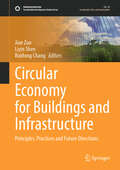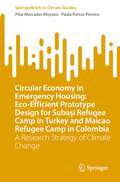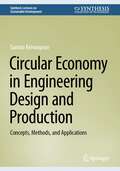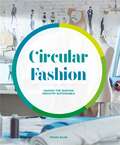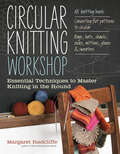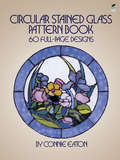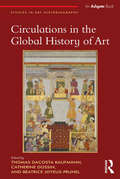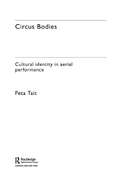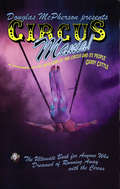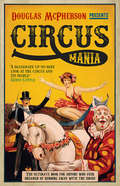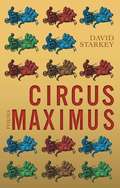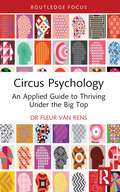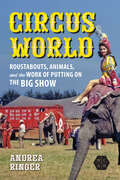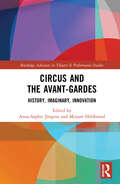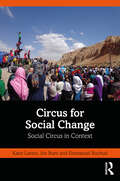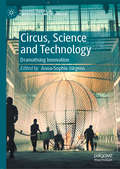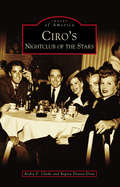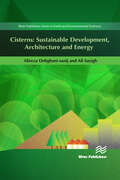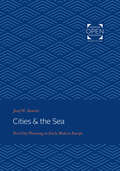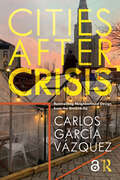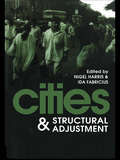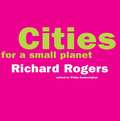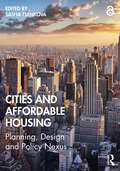- Table View
- List View
Circular Economy for Buildings and Infrastructure: Principles, Practices and Future Directions (Sustainable Development Goals Series)
by Liyin Shen Jian Zuo Ruidong ChangThis edited volume covers theoretical and practical aspects of circular economy in building development, offering chapters dealing with topics such as material design, affordability of housing development, waste management and recycling, smart metering, and more. A particular focus is placed on various stakeholders’ points of view. The book's chapters are co-developed and contributed by multidisciplinary teams including both academics and industry practitioners. The case study-oriented approach taken here helps to facilitate the reader's understanding of how building sustainability can be achieved in the context of circular economy. The building industry has significant environmental, social and economic impacts. As one of the biggest energy consumers and carbon emitters, building sustainability has attracted wide attention globally. Building projects and their associated activities consume a large amount of energy, natural resources and water while producing a large proportion of wastes throughout their lifecycles. The traditional linear approach of “make, use and dispose” has been heavily criticized, whilst the circular approach has gained momentum. Indeed, circular economy has emerged as one of key principles to manage sustainability related issues by means of focusing on the circularity of resources as well as the cost implications.
Circular Economy in Emergency Housing: A Research Strategy of Climate Change (SpringerBriefs in Climate Studies)
by Pilar Mercader-Moyano Paula Porras-PereiraIn recent years, there has been an upsurge in the number of forced displacements due to natural disasters, armed conflicts, and pandemics, which has favoured an increase in the number of temporary accommodations. Although the provision of shelter after an emergency situation is one of the priorities of humanitarian aid, the reality is that the conditions in which people live in a situation of forced displacement are absolutely precarious and overcrowded. Nowadays, this type of housing tends to have a short lifespan, deepening the environmental impact and the generation of waste. Likewise, added to this great problem is the linear economic system implemented worldwide, which also causes a high rate of waste.This investigation develops an eco-efficient design protocol that determines the basic premises in any emergency situation, therefore avoiding the precarious nature to which those in forced displacement are exposed. Moreover, the research investigates different constructive solutions that can respond to situations of natural catastrophes or humanitarian disasters where emergency housing is needed as well as the possible alternatives from the point of view of circular economy. Eco-efficient and environmentally correct solutions are sought, which can be adaptable to the different scenarios where emergency housing may be needed, thus creating a rapid, easy, functional, and environmentally correct architecture, adaptable to these types of situations. The study shows that the factors that characterize emergency architecture can be an example of where the issues around the sustainability factor are applied in a practical way. The main objectives of this study are to develop an eco-efficient design protocol which determines the basic premises in any emergency situation and to find eco-efficient and environmentally correct solutions, adaptable to different scenarios, which have similar climatic characteristics, and where emergency housing may be needed, thus creating a type of ephemeral architecture but sensitive to the user to whom it is intended and in accordance with the optimal conditions of habitability.
Circular Economy in Engineering Design and Production: Concepts, Methods, and Applications (Synthesis Lectures on Sustainable Development)
by Samira KeivanpourThis concise text provides the concepts, methods, and application examples for integrating sustainability into engineering design and production. It discusses the role of sustainability in the value creation processes of various enterprises and different tools and methods for systematic incorporation of social and environmental aspects into the product's life cycle. The following topics are covered: sustainable development in engineering systems and the life cycle concept, norms and standards in the sustainable development and integration of socio-economic assessment into technical valuation, production systems, management of the production systems based on circular economy principles, ecodesign practices, and value creation and innovative design in the circular economy. Provides a concise guide for engineering students for applying circular economy practicesPresents examples and short case studies for understanding the methods and toolsFacilitates understanding and application of the life cycle perspective in product manufacturing and green engineering
Circular Fashion: Making the Fashion Industry Sustainable
by Peggy BlumCreating sustainable fashion has never been more important. Circular Fashion provides an accessible, practical, and holistic approach to this key topic for anyone studying fashion.This introductory text to sustainability in fashion includes best practice case studies and profiles of key companies such as Patagonia, Veja, Christopher Raeburn, and Stella McCartney. It begins with an overview of the fashion business, tackling the issues of the linear production model of make, use, dispose, before introducing the idea of the circular supply chain.Circular Fashion is the must-have book for fashion students, creatives and anyone passionate about sustainability and fashion.
Circular Fashion: Making the Fashion Industry Sustainable
by Peggy BlumCreating sustainable fashion has never been more important. Circular Fashion provides an accessible, practical, and holistic approach to this key topic for anyone studying fashion.This introductory text to sustainability in fashion includes best practice case studies and profiles of key companies such as Patagonia, Veja, Christopher Raeburn, and Stella McCartney. It begins with an overview of the fashion business, tackling the issues of the linear production model of make, use, dispose, before introducing the idea of the circular supply chain.Circular Fashion is the must-have book for fashion students, creatives and anyone passionate about sustainability and fashion.
Circular Knitting Workshop: Essential Techniques to Master Knitting in the Round
by Margaret RadcliffeDiscover the pleasures of knitting in the round! Margaret Radcliffe presents classic circular knitting techniques — including Fair Isle, helix, and tubular — in detailed step-by-step photographic sequences. This comprehensive guide provides directions for 35 demonstration projects, so you can practice each technique on a miniature hat, mitten, or sweater before applying it to a larger project. With tips on how to adapt any straight-needle pattern for use with circular needles, Circular Knitting Workshop opens up endless possibilities.
Circular Stained Glass Pattern Book: 60 Full-Page Designs
by Connie EatonThe dazzling visual effects created by light caught in a myriad of colored glass shapes has fascinated man for centuries. Today stained glass making enjoys increasing popularity, creating an inexhaustible demand for new design ideas.Circular Stained Glass Pattern Book offers glass crafters at every level of experience 60 fresh, elegant motifs in the sought-after circular format. Artist Connie Eaton brings sophisticated design ingenuity to dozens of original compositions -- varied in complexity and offering unlimited possibilities in choice of color, glass cutting, and construction.The circular shape provides a picturesque frame for inspiring floral and foliate elements, stylized heads, suns, landscapes, pastoral scenes, abstracts, and more. Patterns can be used directly, enlarged or reduced to suit your needs.You'll find this versatile collection ideal for making beautiful stained glass windowpanes, mobiles, mirrors, candle shelters, room dividers, ornamental boxes, and other creations sure to be one-of-a-kind showpieces that will be treasured for years to come.
Circulations in the Global History of Art (Studies in Art Historiography)
by Catherine Dossin Thomas Kaufmann Béatrice Joyeux-PrunelThe project of global art history calls for balanced treatment of artifacts and a unified approach. This volume emphasizes questions of transcultural encounters and exchanges as circulations. It presents a strategy that highlights the processes and connections among cultures, and also responds to the dynamics at work in the current globalized art world. The editors’ introduction provides an account of the historical background to this approach to global art history, stresses the inseparable bond of theory and practice, and suggests a revaluation of materialist historicism as an underlying premise. Individual contributions to the book provide an overview of current reflection and research on issues of circulation in relation to global art history and the globalization of art past and present. They offer a variety of methods and approaches to the treatment of different periods, regions, and objects, surveying both questions of historiography and methodology and presenting individual case studies. An 'Afterword' by James Elkins gives a critique of the present project. The book thus deliberately leaves discussion open, inviting future responses to the large questions it poses.
Circus Bodies: Cultural Identity in Aerial Performance
by Peta TaitThis pioneering study is one of the major publications in the increasingly popular and largely undocumented area of circus studies. Through photographs and illustrations, Peta Tait presents an extraordinary survey of 140 years of trapeze acts and the socially changing ideas of muscular action in relation to our understanding of gender and sexuality. She questions how spectators see and enjoy aerial actions, and what cultural identities are presented by bodies in fast, physical aerial movement. Adeptly locating aerial performance within the wider cultural history of bodies and their identities, Circus Bodies explores this subject through a range of films such as Trapeze (1956) and Wings of Desire (1987) and Tait also examines live performances including: * the first trapeze performers: Léotard and the Hanlon Brothers* female celebrities; Azella, Sanyeah, black French aerialist LaLa, the infamous Leona Dare, and the female human cannonballs* twentieth-century gender benders; Barbette and Luisita Leers* the Codonas, Concellos, Gaonas, Vazquez and Pages troupes* imaginative aerial acts in Cirque de Soleil and Circus Oz productions. This book will prove an invaluable resource for all students and scholars interested in this fascinating field.
Circus Mania!
by Douglas McphersonA history of the circus from its origins in the Roman times, through its establishment in Western Europe, and to the modern day circus--absolutely diverse and captivating Circuses have existed since Roman times, but centuries later, the circus world has never been more diverse and captivating, the global success of Cirque du Soleil testament to its enduring and universal appeal. Traditional family circuses for kids, arty cirque-style shows for adults, circuses in tents or in theaters, circuses with animals or without, cabaret-style hybrids on the burlesque circuit--this is an expert guide to their extraordinary history and culture. The circus requires a unique type of performer, people who blend the discipline of sports stars with the razzmatazz of showbiz; itinerant but clannish entertainers who have often had circus blood in their families for generations; world class gymnasts who risk death twice daily and help take down the big top afterwards. This history offers a journey into this unique world, each chapter an access-all-areas pass to a different circus, talking to the trapeze flyers, clowns, animal trainers, and showmen about their lives, work, families, customs, and traditions.
Circus Mania: The Ultimate Book for Anyone Who Ever Dreamed of Running Away with the Circus
by Douglas McPhersonRoll up! Roll up! See the wondrous new face of Circus Mania, 250 years in the making! Full of the remarkable tales of circus life that made it a classic on its first outing. Learn about the origins of the circus from Roman times, to the colourful characters that make the circus the international phenomenon it is today. Circus Mania 2.0 is bigger, better and couldn't be timelier. Two hundred and fifty years after Philip Astley invented the circus it has never been more diverse and captivating, the global success of the spectacular Cirque du Soleil just one testament to its enduring and universal appeal. In Britain alone there are traditional family circuses for kids and arty shows for adults, circuses in tents and circuses in theatres, circuses with animals and circuses without, the Circus of Horrors for clubbers, the comedy-based Circus Hilarious and cabaret-style hybrids on the burlesque circuit and this form of entertainment is popular around the world. What all circuses have in common are the extraordinary skills, dedication and lifestyle of those involved a unique strain of performers who blend the discipline of sports stars with the razzmatazz of showbiz; itinerant entertainers who have often had circus blood in their families for generations; world-class gymnasts who risk death twice daily, serve on the tea stand in between shows and help take down the big top afterwards. Circus Mania is a journey into this unique world, each chapter an access-all-areas pass to a different circus, talking to the trapeze flyers, clowns, animal trainers and showmen about their lives, work and customs and offering insight into the development of this traditional entertainment from the earliest times.
Circus Maximus
by David StarkeyWhat would the Son-of-Man get up to in present-day Rome? Would he wander the Galleria Borghese, loiter outside nightclubs, ride trams, tip accordionists? How would Keats feel about the neon Dior sign that flashes away above the Spanish Steps? Are there ways to avoid Vespas on the sidewalks? Rules for carving a Pietà? And exactly which painter is responsible for the ugliest Jesus in the history of Western Art?A tour of Rome like no other, the poems of Circus Maximus ask these questions and more. Join David Starkey as he shines a torch on the sights, sounds, mysteries and metaphors of the Eternal City.David Starkey is the former Poet Laureate of Santa Barbara, a senior Fulbright scholar, and a six-time nominee for the Pushcart Prize. His latest volume of poetry is A Few Things You Should Know About the Weasel (Biblioasis, 2010).
Circus Psychology: An Applied Guide to Thriving Under the Big Top
by Fleur van RensThe lives of circus artists can be mentally and physically demanding. Circus Psychology: An Applied Guide to Thriving Under the Big Top is an evidence-based guide to nurturing the mental health of circus artists while enabling them to perform at the peak of their capacities. The book is organised into three accessible sections: mental health in circus, optimising the circus environment to facilitate thriving, and mental skills for thriving in circus. The first section introduces general mental health concepts, provides insight into the mental health of circus artists, the stress process, and the role of psychological resilience and perfectionism in mental health. The second section offers insight into motivation and engagement in circus, the features of a psychologically safe circus environment, and advice on psychologically supportive talent development environment. The final section explains, applies, and provides practice material for mental skills, including goal setting, self-talk, mental imagery, arousal regulation, and visual anticipation. Written by Dr Fleur van Rens, a circus artist and lecturer in sport psychology, this book is an essential resource for those passionate about the mental health of amateurs and professionals in the circus industry.
Circus World: Roustabouts, Animals, and the Work of Putting on the Big Show (Working Class in American History)
by Andrea RingerFrom the 1870s to the 1960s, circuses crisscrossed the nation providing entertainment. A unique workforce of human and animal laborers from around the world put on the show. They also formed the backbone of a tented entertainment industry that raised new questions about what constituted work and who counted as a worker. Andrea Ringer examines the industry-wide circus world--the collection of shows that traveled by rail, wagon, steamboat, and car--and the traditional and nontraditional laborers who created it. Performers and their onstage labor played an integral part in the popularity of the circus. But behind the scenes, other laborers performed the endless menial tasks that kept the show on the road. Circus operators regulated employee behavior both inside and outside the tent even as the employees themselves blurred the line between leisure and labor until, in all parts of the show, the workers could not escape their work. Illuminating and vivid, Circus World delves into the gender, class, and even species concerns within an extinct way of life.
Circus and the Avant-Gardes: History, Imaginary, Innovation (Routledge Advances in Theatre & Performance Studies)
by Anna-Sophie Jürgens and Mirjam HildbrandThis book examines how circus and circus imaginary have shaped the historical avant-gardes at the beginning of the 20th century and the cultures they help constitute, to what extent this is a mutual shaping, and why this is still relevant today. This book aims to produce a better sense of the artistic work and cultural achievements that have emerged from the interplay of circus and avant-garde artists and projects, and to clarify both their transhistorical and trans-medial presence, and their scope for interdisciplinary expansion. Across 14 chapters written by leading scholars – from fields as varied as circus, theatre and performance studies, art, media studies, film and cultural history – some of which are written together with performers and circus practitioners, the book examines to what extent circus and avant-garde connections contribute to a better understanding of early 20th century artistic movements and their enduring legacy, of the history of popular entertainment, and the cultural relevance of circus arts. Circus and the Avant-Gardes elucidates how the realm of the circus as a model, or rather a blueprint for modernist experiment, innovation and (re)negotiation of bodies, has become fully integrated in our ways of perceiving avant-gardes today. The book does not only map the significance of circus/avant-garde phenomena for the past, but, through an exploration of their contemporary actualisations (in different media), also carves out their achievements, relevance, and impact, both cultural and aesthetic, on the present time.
Circus for Social Change: Social Circus in Context (Routledge Advances in Theatre & Performance Studies)
by Katie Lavers Jon Burtt Emmanuel BochudIn this volume Social Circus is explored in depth by three Circus Studies scholars working with the aim of creating new ways of engaging with the field.Lavers, Burtt, and Bochud investigate the way that Social Circus transforms in response to its immediate environment, and particularly its social, political, and cultural context. Extensively illustrated, with photos of different Social Circuses around the world, and extensively annotated, Circus for Social Change: Social Circus in Context provides a portal into ways of seeing today’s Social Circus and is of interest to practitioners and scholars. Social Circuses explored in this volume include Cirqiniq in far North Canada; Galway Community Circus in the Republic of Ireland; Zip Zap Circus in Cape Town, South Africa; Circus Harmony in St. Louis, Missouri; Circus Laheto in Central Brazil; Women’s Circus in Melbourne, Australia; the Mobile Mini Children’s Circus (the MMCC) in various locations across Afghanistan; Cirque Hors Piste in Montreal, Canada; Sencirk in Dakar, Senegal; the Slow Circus Academy in Yokohama, JDS/Juggling de Shinshu, and the Moon Night Project in Nagano, Japan; Ponleu Selpak’s Performing Arts School and Phare Circus in Cambodia; Sirkus Magenta in Helsinki, Finland; and Le Plus Petit Cirque du Monde in Bagneux in the outskirts of Paris, France.This book will be of great interest to the general reader, to practitioners working within Social Circus or arts for social change, and to scholars, teachers, and students in schools, colleges, and universities.
Circus, Science and Technology: Dramatising Innovation (Palgrave Studies in Performance and Technology)
by Anna-Sophie JürgensThis book explores the circus as a site in and through which science and technology are represented in popular culture. Across eight chapters written by leading scholars – from fields as varied as performance and circus studies, art, media and cultural history, and engineering – the book discusses to what extent the engineering of circus and performing bodies can be understood as a strategy to promote awe, how technological inventions have shaped circus and the cultures it helps constitute, and how much of a mutual shaping this is. What kind of cultural and aesthetic effects does engineering in circus contexts achieve? How do technological inventions and innovations impact on the circus? How does the link between circus and technology manifest in representations and interpretations – imaginaries – of the circus in other media and popular culture? Circus, Science and Technology examines the ways circus can provide a versatile frame for interpreting our relationship with technology.
Ciro's: Nightclub of the Stars (Images of America)
by Andra D. Clarke Regina Denton-DrewMany entertainers launched their careers at Ciro's Nightclub, often referred as "The Nightclub of the Stars." Ciro's was patronized by both famous and non-famous guests who enjoyed dancing, dining, and comedy routines featuring top-name entertainers such as Jerry Lewis, Dean Martin, Sophie Tucker, Judy Garland, Peggy Lee, Liberace, Nat King Cole, Joe E. Lewis, and Sammy Davis Jr.--just to name a few. The nightclub's house band was led by Dick Stabile, although bandleader Xavier Cugat, best known for popularizing the rumba in the United States, was a regular headliner at the club. The elite Hollywood regulars at Ciro's included some of the most popular names in entertainment at the time, such as Marilyn Monroe, Frank Sinatra, Cary Grant, Humphrey Bogart, and many more.
Cisterns: Sustainable Development, Architecture and Energy
by Ali Sayigh Alireza Dehghani-sanijCisterns: Sustainable Development, Architecture and Energy was written on beliefs that based on historical evidence and actual findings, Iran is most probably the country where cisterns, or Aub-anbars in Farsi, were first developed and built. Therefore, it is quite natural for the author to name cisterns in the text Aub-anbars, as it has been called for centuries in this country, the translation of the same name having been used in other countries too. Although in some books, journals and papers published out of Iran by foreign and Iranian scholars, the names Cistern or Water Reservoir have been used. The word Aub-anbar is a compound noun in Farsi; Aub means water and Anbar means tank/reservoir. Putting them together gives the noun Aub-anbarand it should be used as one word.People of the region wanting reserved cool water whether in cities or in different locations across the harsh desert during their travel. Queen Zubeida, the wife of Khalifa Haroon Al-Rasheed in 750 AD built one of these cistern closer to the town of Hiyal in Saudi Arabia so that the Pilgrims? Caravans going to Mecca will have cool, fresh water. This book consists of 11-chapters with full analysis, illustrations and photographs. It makes interesting readings to those interested into vernacular architecture, traditional buildings and creative thinking.
Cities & the Sea: Port City Planning in Early Modern Europe
by Josef W. KonvitzOriginally published in 1978. Josef Konvitz provides a broad comparative study of European port cities since the Renaissance by examining how they were built and rebuilt in the context of urban industrialization. Konvitz argues that as seafaring became more critical to Western civilization, intellectuals and rulers placed more importance on urban planning. Planning looked different, of course, in various European cities. In Paris, riverside planning was patched into the existing frame of the city, whereas Scandinavian towns on the Baltic were over-designed to accommodate a degree of maritime trade unsustainable for cities writ large. In the eighteenth century, city planning fell out of vogue, and new solutions were introduced to help solve the problems created by urban development. With a series of helpful maps, Konvitz's book is an important source for urban historians of early modern Europe.
Cities After Crisis: Reinventing Neighborhood Design from the Ground-Up
by Carlos Garcia VazquezCities After Crisis shows how urbanism and urban design is redefining cities after the global health, economic, and environmental crises of the past decades. The book details how these crises have led to a new urban vision—from avantgarde modern design to an artisan aesthetic that calls for simplicity and the everyday, from the sustainable development paradigm to a resilient vision that defends de-growth and the re-wilding of cities, from a homogenizing globalism to a new localism that values what is distinctive and nearby, from the privatization of the public realm to the commoning and self-governance of urban resources, and from top-down to bottom-up processes based on the engagement and empowerment of communities. Through examples from cities around the world and a detailed look at the London neighbourhood of Dalston, the book shows designers and planners how to incorporate residents into the decision-making process, design inclusive public spaces that can be permanently reconfigured, reimagine obsolete spaces to accommodate radically contemporary uses, and build gardens designed and maintained by the community, among other projects.
Cities And Structural Adjustment
by Nigel Harris Ida FabriciusThis work addresses the challenge faced in the management of major cities throughout the world as they adjust to economic reform and, in particular, to becoming more open to the processes operating in worldwide markets. Such processes have already had some dramatic effects on large cities in developed and developing countries - the rapid decline in manufacturing in older industrial cities and the emergence of the servicing city are but two of the more striking outcomes. Based on substantial case studies of cities in the developed and the developing world - Sheffield, Barcelona, Lille, Mexico City, Monterrey, Santiago de Chile, Bogota, Kingston Jamaica and Johannesburg - themes are drawn out, extending from structural economic change to policy reactions, new city initiatives, management, planning and finance.
Cities For A Small Planet
by Richard RogersNothing else damages the earth's environment more than our cities. As the world's population has grown, our cities have burgeoned, and their impact on the environment worsened. Meanwhile, from the isolated, gated communities within Houston and Los Angeles, to the millions of residents of Bombay living in squalor, the city has failed to serve its ideal function--as the cradle of civilization, the engine of culture, and the inspiration for community and citizenship. In Cities for a Small Planet, Sir Richard Rogers, one of the world's leading architects and the designer of the Pompidou Center in Paris, demonstrates how future cities could provide the springboard for restoring humanity's harmony with its environment.Rogers outlines the disastrous impact cities have had and will continue to have on our world, from waste-saturated Tokyo Bay, to the massive plumes of pollution caused by London's traffic, to the depleted water resources of Mexico City. He traces these problems to the underlying social and cultural values that create them--unchecked commercial zeal, selfish individualism, and a lack of community. Bringing to bear concepts such as that of "open-minded" space--places within cities that serve multiple functions such as markets, parks, and sidewalk cafes--he explains how urban design can be used to give citizens a sense of shared experience. The city built with comfortable and safe public space can bring diverse groups together and breed a sense of tolerance, awareness, identity, and mutual respect. He calls for a new theoretical shift in the way cities do business and interact with the environment, arguing that many products come to market and are sold without figuring their social or environmental cost.Rogers goes on to describe the city of the future: one that is sustainable within its own environment; that can make a positive impact on its surroundings; that encourages communication among its citizens; that is compact and focused around neighborhoods; and that is beautiful, a city whose buildings and spaces spark the creative potential of its inhabitants.As our population grows larger, our planet grows smaller. Cities for a Small Planet is a passionate and eloquent blueprint for the cities we must create in response, cities that provide for the needs of both their residents and the earth on which they live.
Cities Without Cities: An Interpretation of the Zwischenstadt
by Thomas SievertsThis book investigates the characteristics of today's built environment: no longer simply a city but increasingly large conurbations made up of a number of development clusters, linked by transport routes. The diffusion of the once compact city into a city web, the 'meta city' is mirrored by changes in society from communities with strong social cohesion and interest in their towns and cities to individuals pursing their own goals, with global social links and little interest in their city.
Cities and Affordable Housing: Planning, Design and Policy Nexus
by Sasha TsenkovaThis book provides a comparative perspective on housing and planning policies affecting the future of cities, focusing on people- and place-based outcomes using the nexus of planning, design and policy. A rich mosaic of case studies features good practices of city-led strategies for affordable housing provision, as well as individual projects capitalising on partnerships to build mixed-income housing and revitalise neighbourhoods. Twenty chapters provide unique perspectives on diversity of approaches in eight countries and 12 cities in Europe, Canada and the USA. Combining academic rigour with knowledge from critical practice, the book uses robust empirical analysis and evidence-based case study research to illustrate the potential of affordable housing partnerships for mixed-income, socially inclusive neighbourhoods as a model to rebuild cities. Cities and Affordable Housing is an essential interdisciplinary collection on planning and design that will be of great interest to scholars, urban professionals, architects, planners and policy-makers interested in housing, urban planning and city building.
